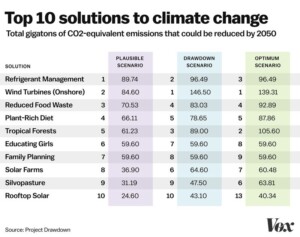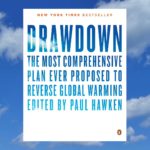Yes, says Paul Hawken, author of ‘Drawdown – The Most Comprehensive Plan Ever Proposed to Reverse Global Warming’ if most of the 100 solutions suggested in the book are implemented by 2050. The good news is, most of the solutions already exist
The subtitle of the book, he says, is deliberately made to sound brash. “We chose that description because no detailed plan to reverse warming has been proposed. There have been agreements and proposals on how to slow, cap, and arrest emissions, and there are international commitments to prevent global temperature increases from exceeding two degrees centigrade over pre-industrial levels.”
The book is not a hallucination of an environmentalist-entrepreneur. It is based on meticulous research by 70 leading scientists and policymakers around the world from 22 countries. They
came together to offer a set of realistic and bold solutions to climate change as part of a
three-years project.
The book’s blurb states: “Drawdown maps, measures, models, and describes the 100 most substantive solutions to global warming. For each solution, it describe its history, the carbon impact it provides, the relative cost and savings, the path to adoption, and how it works. All solutions modeled are already in place, well understood, analyzed based on peer-reviewed science, and are expanding around the world.”
Blueprint Already Exists
During the research process the author says: “We found a plan, a blueprint that already exists in the world in the form of humanity’s collective wisdom, made manifest in applied, hands-on practices and technologies. Individuals, communities, farmers, cities, companies, and governments have shown that they care about this planet, its people, and its places. Engaged citizens world over are doing something extraordinary. This is their story.”
Surprisingly, the author makes one believe that reversing global warming doesn’t seem like a mega effort. “The solutions exist, are economically viable, and communities throughout the world are currently enacting them with skill and determination. If deployed collectively on a global scale over the next thirty years, they represent a credible path forward, not just to slow the earth’s warming but to reach drawdown, that point in time when greenhouse gases in the atmosphere peak and begin to decline. These measures promise cascading benefits to human health, security, prosperity, and well-being—giving us every reason to see this planetary crisis as an opportunity to create a just and livable world.”
Highlights
- The number one solution, in terms of potential impact?
A combination of educating girls and family planning, which together could reduce 120 gigatons of CO2 – equivalent by 2050 — more than on and offshore wind power combined (99 GT). It is the 1.1 billion fewer people that are going to do the carbon work? - Reduced food waste and plant-rich diets on their own, beat solar farms and rooftop solar combined.
- Farmland restoration: There’s over a billion hectares of abandoned land all over the world. They can be regenerated using animals, using cover, using no-till. It could become the big carbon sink.
Despite the 100 workable solutions, one thing not in the researchers’ hand is assessing the carbon benefit of absence of war or peace in the next 30 years.
 What about the Trump effect? Hawken says federal governments in the US have had little impact on climate issues. “States have led; cities have led, but never the federal government. It’s just that people in the United States think that they’re the leaders on this stuff. They’re not. It’s Germany, China, France, Denmark.”
What about the Trump effect? Hawken says federal governments in the US have had little impact on climate issues. “States have led; cities have led, but never the federal government. It’s just that people in the United States think that they’re the leaders on this stuff. They’re not. It’s Germany, China, France, Denmark.”
Drawdown 2
Even before the shock of the author’s brazen optimism sinks in, Hawken has announced a sequel. He has started work on Drawdown 2 and expects to add 60 more solutions – “things that are nascent, on the horizon or just below the horizon. They are game-changers, a lot of them. Some of them will fail. It’s hard to say which will or won’t,” He said.
“It’s unrealistic to think that this is our portfolio for the next 30 years. It’s not true. That’s why the next book is important — one out of five or six of these [future solutions] is really going to make a difference.” Paul Hawken told David Roberts of Vox in a recent interview.
Paul Hawken is an environmentalist, entrepreneur, author and activist. He has dedicated  his life to environmental sustainability and changing the relationship between business and the environment. He is one of the environmental movement’s leading voices, and a pioneering architect of corporate reform with respect to ecological practices.
his life to environmental sustainability and changing the relationship between business and the environment. He is one of the environmental movement’s leading voices, and a pioneering architect of corporate reform with respect to ecological practices.
His work includes founding successful, ecologically conscious businesses, writing about the impacts of commerce on living systems, and consulting with heads of state and CEOs on economic development, industrial ecology, and environmental policy. Paul is Executive Director of Project Drawdown, a non-profit dedicated to researching when and how global warming can be reversed. The organization maps and models the scaling of one hundred substantive technological, social, and ecological solutions to global warming.
His new book entitled Carbon; The Business of Life is going to be published by Penguin Random House in 2018.
In 2014 he was named one of the three Pioneers of Sustainability along with Professors Peter Senge and Michael Porter.
http://www.drawdown.org/the-book
By Benedict Paramanand










